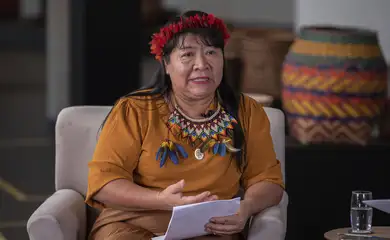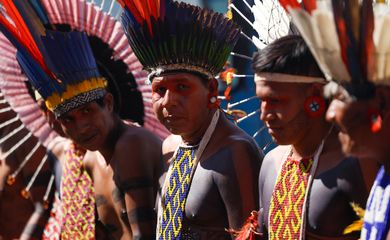Indigenous people welcome return of 16th-17th century cloak to Brazil

The return of a Tupinambá cloak made from red guará bird feathers to Brazil, after more than three centuries in storage in Denmark, was a reason for celebration among the indigenous people in southern Bahia. The Danish National Museum donated the artifact to the National Museum in Rio de Janeiro.

The Brazilian museum confirmed the cloak's arrival on July 11 and announced plans to exhibit the piece in the coming weeks.
However, ten other similar cloaks, also made from guará feathers, remain in European museums, according to a survey by American researcher Amy Buono from Chapman University in California, USA.
According to the research, there are four more cloaks in the National Museum of Denmark, in addition to the one that was returned to Brazil. The Natural History Museum of the University of Florence, Italy, holds two others. Additionally, Tupinambá cloaks can be found in the Museum of Cultures in Basel, Switzerland; the Royal Museum of Art and History in Brussels, Belgium; the Quai Branly Museum in Paris, France; and the Ambrosian Library in Milan, Italy.
The National Museum in Rio de Janeiro stated, however, that there are currently no negotiations underway to bring these other cloaks back to Brazil.
The leader of the Tupinambás of Olivença in Bahia state, indigenous chief Jamopoty, emphasizes the importance of reclaiming these cloaks currently held abroad. "It's crucial to return what isn't theirs. They must return what rightfully belongs to us. Our heritage strengthens our identity," states the indigenous leader.
The return of the indigenous mantle is the culmination of a struggle led by chief Jamopoty's community, which began in 2000 when Tupinambá leader Amotara first saw the piece at a special exhibition in São Paulo commemorating the 500th anniversary of the Portuguese arrival in Brazil.
"She drafted a document with the Tupinambá Council, requesting that the mantle remain in Brazil because it needed to return to her people. Amotara wished for the mantle to come to Olivença," explains Jamopoty.
Despite Amotara's plea, the cloak returned to Denmark after the exhibition ended. It would be another 24 years before the garment finally returned to Brazil, this time to stay.
According to Amy Buono's research, the Tupinambá cloaks, known as assojaba or guara-abucu in the ancient Tupi language, were all made between the 16th and 17th centuries. These garments were used in religious rituals within indigenous communities, as well as in missionary settlements during the first two centuries of Portuguese colonization.
Plumage artifacts, including garments made with colored feathers, were used by these indigenous people even before the arrival of the Portuguese. They were described by Pero Vaz de Caminha, the scribe of the first Portuguese fleet to arrive in Brazil in the 16th century, in his famous letter to King Manuel of Portugal.
From the first Portuguese voyage to Brazil, indigenous artifacts were taken to Europe and continued to be exported over the following decades. These items served as evidence of the "discovery" of the new territory and became valuable additions to European collections.
The Brazilian government has been actively working to repatriate indigenous artifacts. Last Wednesday (Jul. 10), 585 pieces from the Natural History Museum in Lille, France, were returned to Brazil. These objects come from over 40 different indigenous groups, according to the national indigenous authority, Funai.



